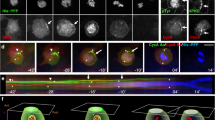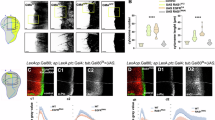Abstract
The polarized architecture of epithelial cells depends on the highly stereotypic distribution of cellular junctions and other membrane-associated protein complexes. In epithelial cells of the Drosophila embryo, three distinct domains subdivide the lateral plasma membrane. The most apical one comprises the subapical complex (SAC). It is followed by the zonula adherens (ZA) and, further basally, by the septate junction1. A core component of the SAC is the transmembrane protein Crumbs, the cytoplasmic domain of which recruits the PDZ-protein Discs Lost into the complex2,3. Cells lacking crumbs or the functionally related gene stardust fail to organize a continuous ZA and to maintain cell polarity4,5,6. Here we show that stardust provides an essential component of the SAC. Stardust proteins colocalize with Crumbs and bind to the carboxy-terminal amino acids of its cytoplasmic tail. We introduce two different Stardust proteins here: one MAGUK protein, characterized by a PDZ domain, an SH3 domain and a guanylate kinase domain; and a second isoform comprising only the guanylate kinase domain. The Stardust proteins represent versatile candidates as structural and possibly regulatory constituents of the SAC, a crucial element in the control of epithelial cell polarity.
This is a preview of subscription content, access via your institution
Access options
Subscribe to this journal
Receive 51 print issues and online access
$199.00 per year
only $3.90 per issue
Buy this article
- Purchase on SpringerLink
- Instant access to full article PDF
Prices may be subject to local taxes which are calculated during checkout





Similar content being viewed by others
References
Müller, H. A. J. Genetic control of epithelial cell polarity: lessons from Drosophila. Dev. Dyn. 218, 52–67 (2000).
Bhat, M. A. et al. Discs Lost, a novel multi-PDZ domain protein, establishes and maintains epithelial polarity. Cell 96, 833–845 (1999).
Klebes, A. & Knust, E. A conserved motif in Crumbs is required for E-cadherin localisation and zonula adherens formation in Drosophila. Curr. Biol. 10, 76–85 (2000).
Tepass, U. & Knust, E. Crumbs and stardust act in a genetic pathway that controls the organization of epithelia in Drosophila melanogaster. Dev. Biol. 159, 311–326 (1993).
Grawe, F., Wodarz, A., Lee, B., Knust, E. & Skaer, H. The Drosophila genes crumbs and stardust are involved in the biogenesis of adherens junctions. Development 122, 951–959 (1996).
Tepass, U. Crumbs, a component of the apical membrane, is required for zonula adherens formation in primary epithelia of Drosophila. Dev. Biol. 177, 217–225 (1996).
Dimitratos, S. D., Woods, D. F., Stathakis, D. G. & Bryant, P. J. Signaling pathways are focused at specialized regions of the plasma membrane by scaffolding proteins of the MAGUK family. Bioessays 21, 912–921 (1999).
Kamberov, E. et al. Molecular cloning and characterization of Pals, proteins associated with mLin-7. J. Biol. Chem. 275, 11425–11431 (2000).
Müller, H. A. & Wieschaus, E. armadillo, bazooka, and stardust are critical for early stages in formation of the zonula adherens and maintenance of the polarized blastoderm epithelium in Drosophila. J. Cell Biol. 134, 149–163 (1996).
Schober, M., Schaefer, M. & Knoblich, J. A. Bazooka recruits Inscuteable to orient asymmetric cell divisions in Drosophila neuroblasts. Nature 402, 548–551 (1999).
Wodarz, A., Ramrath, A., Kuchinke, U. & Knust, E. Bazooka provides an apical cue for Inscuteable localization in Drosophila neuroblasts. Nature 402, 544–547 (1999).
Wodarz, A., Ramrath, A., Grimm, A. & Knust, E. Drosophila atypical protein kinase C associates with Bazooka and controls polarity of epithelia and neuroblasts. J. Cell Biol. 150, 1361–1374 (2000).
Petronczki, M. & Knoblich, J. A. DmPAR-6 directs epithelial polarity and asymmetric cell division of neuroblasts in Drosophila. Nature Cell Biol. 3, 43–49 (2001).
Tepass, U., Theres, C. & Knust, E. crumbs encodes an EGF-like protein expressed on apical membranes of Drosophila epithelial cells and required for organization of epithelia. Cell 61, 787–799 (1990).
McGee, A. W. & Bredt, D. S. Identification of an intramolecular interaction between the SH3 and guanylate kinase domains of PSD-95. J. Biol. Chem. 274, 17431–17436 (1999).
Shin, H., Hsueh, Y.-I., Yang, F.-C., Kim, E. & Sheng, M. An intramolecular interaction between Src homology 3 domain and guanylate kinase-like domain required for channel clustering by postsynaptic density-95/SAP90. J. Neurosci. 20, 3580–3587 (2000).
Wu, H. et al. Intramolecular interactions regulate SAP97 binding to GKAP. EMBO J. 19, 5740–5751 (2000).
Nix, S. L., Chishti, A. H., Anderson, J. M. & Walther, Z. hCASK and hDlg associate in epithelia, and their Src homology 3 and guanylate kinase domains participate in both intramolecular and intermolecular interactions. J. Biol. Chem. 275, 41192–41200 (2000).
Dimitratos, S. D., Woods, D. F. & Bryant, P. J. Camguk, Lin-2, and CASK: novel membrane-associated guanylate kinase homologs that also contain CaM kinase domains. Mech. Dev. 63, 127–130 (1997).
Lammel, U. & Saumweber, H. X-linked loci of Drosophila melanogaster causing defects in the morphology of the embryonic salivary gland. Dev. Genes Evol. 10, 525–535 (2000).
Rorth, P. A modular misexpression screen in Drosophila detecting tissue-specific phenotypes. Proc. Natl Acad. Sci. USA 93, 12418–12422 (1996).
Rubin, G. M. & Spradling, A. C. Vectors for P-element-mediated gene transfer in Drosophila. Nucleic Acids Res. 11, 6341–6351 (1983).
Wodarz, A., Hinz, U., Engelbert, M. & Knust, E. Expression of Crumbs confers apical character on plasma membrane domains of ectodermal epithelia of Drosophila. Cell 82, 67–76 (1995).
Han, K. & Manley, J. L. Functional domains of the Drosophila Engrailed protein. EMBO J. 12, 2723–2733 (1993).
Tower, J., Karpen, G. H., Craig, N. & Spradling, A. C. Preferential transposition of Drosophila P-elements to nearby chromosomal sites. Genetics 133, 347–359 (1993).
Brown, N. H. & Kafatos, F. C. Functional cDNA libraries from Drosophila embryos. J. Mol. Biol. 203, 425–437 (1988).
Hovemann, B. T., Dessen, E., Mechler, H. & Mack, E. Drosophila snRNP associated protein P11 which specifically binds to heat shock puff 93D reveals strong homology with hnRNP core protein A1. Nucleic Acids Res. 19, 4909–4914 (1991).
Kennerdell, J. R. & Carthew, R. W. Use of dsRNA-mediated genetic interference to demonstrate that frizzled and frizzled 2 act in the Wingless pathway. Cell 95, 1017–1026 (1998).
Brand, A. H. & Perrimon, N. Targeted gene expression as a means of altering cell fates and generating dominant phenotypes. Development 118, 401–415 (1993).
Oda, H., Uemura, T., Harada, Y., Iwai, Y. & Takeichi, M. A Drosophila homolog of cadherin associated with armadillo and essential for embryonic cell–cell adhesion. Dev. Biol. 165, 716–726 (1994).
Acknowledgements
We thank N. Brown, B. Hovemann, M. Schäfer and C. M. Schuster for cDNA libraries, M. A. Bhat, D. Cavener and T. Uemura for antibodies, A. Ramrath for help with the yeast two-hybrid assay, and J. A. Campos-Ortega, K. Johnson, A. Müller and A. Wodarz for discussions and critical reading of the manuscript. The work was supported by the Deutsche Forschungsgemeinschaft and the Fonds der Chemischen Industrie.
Author information
Authors and Affiliations
Corresponding author
Supplementary information

Figure 3.1
(JPG 175 KB)
Rights and permissions
About this article
Cite this article
Bachmann, A., Schneider, M., Theilenberg, E. et al. Drosophila Stardust is a partner of Crumbs in the control of epithelial cell polarity. Nature 414, 638–643 (2001). https://doi.org/10.1038/414638a
Received:
Accepted:
Published:
Issue Date:
DOI: https://doi.org/10.1038/414638a



